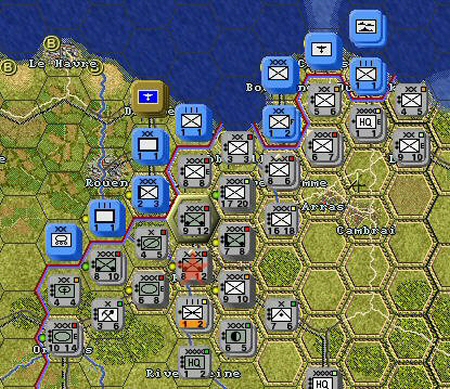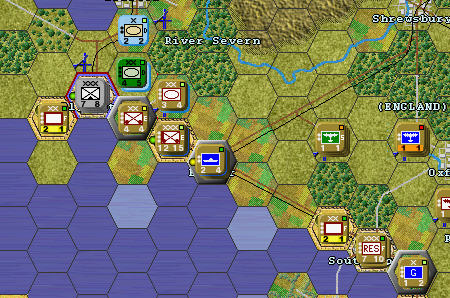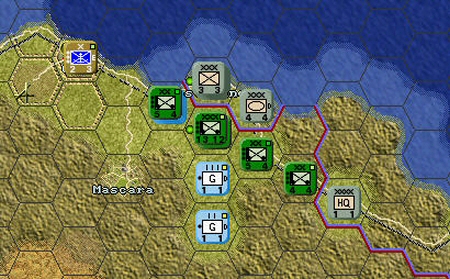Europe Aflame Interactive Combat Story: Episode IV
Summary of what happened in Episode III: [actions based on survey results by our readers].
On April 28, 1940, after a fierce battle that raged around the city for two weeks, German forces entered Paris. As the defeated French government began preparations to negotiate with their conquerors, the Wehrmacht pushed on towards Dunkirk, where the routed British Royal Marines were attempting to retreat back to England. Heavy bombardment by the Royal Navy slowed the pursuit, and allowed the exhausted Brits to make good their escape. On May 5, 1940, the French officially surrendered to the Axis.

Paris falls to the Axis
{default}Correctly interpreting the rapidly deteriorating situation just prior to the fall of the capital, the Allied Supreme Commander ordered the British Expeditionary Force (BEF) and DeGaulle’s newly-reformed 4th Armoured Division to secure ports several hundred kilometers behind the front. This fortuitous action allowed the withdrawal of these forces to the UK, where they shall live to fight another day. Alas, this was the only bright spot in what was indeed a very dark moment for the Allied forces.
(For complete details on the Fall of France, please click here).
The stunningly quick defeat of the French forces, once thought to be the cream of the world’s military, had further repercussions on the already disheartened Allies. Lightning negotiations between Berlin and Madrid saw Franco throw his hat in with the Axis powers, and declare war on the Allies. Ceding former French colonies in Africa to the Spanish, Germany had gained another ally. This turned out to be a mixed blessing for the Axis, however… Backstabbing the traitorous Vichy French had once again caused them to change allegiance, and swear to fight for the Allied cause to the death. Substantial Vichy forces joined their Free-French brothers, and bolstered the Allied ranks at a most desperate time.
Spain joins the Axis cause (click on image to enlarge)
This series of events did not go unnoticed by the ‘slumbering giant’ to the west, however. The rapid defeat of France, ceaseless bombing of England’s cities and airfields, and constant pressure from British diplomats were beginning to take their toll on the neutralist population of the United States. Spain’s entry into the war, which would certainly spell the end of British-held Gibraltar and the lifeline convoys to and from the Mediterranean, might alone have been enough to cause the Americans to join the Allied cause. Yet there was more stunning news…
The icing-on-the-cake proved to be the discovery that the Germans had secretly been converting their industrial base towards a full war economy for several years. Their potential is far greater than was earlier anticipated, and the amount of equipment and vehicles the Germans could field was likely to be considerably higher than expected. The public outcry of the American citizenry was stunning. Emboldened by this new turn of events, Roosevelt called for a Declaration of War (DoW) against the Axis powers. The American Congress, by the narrowest of margins, had agreed.
The United States was at war.
(For complete details on Spain, the Vichy French, and the entry of the Americans, please click here).
May 19, 1940 saw the beginning of the Battle of Britain. Fierce battles raged in the skies above England as the German and Italian air forces strived for dominance over the valiant RAF (Royal Air Force). With tremendous damage done both to the vital airfields and large population centres such as London itself, the Axis took control of the skies. The situation went from bad to worse, as June 23 saw the Axis capture of Gibraltar. By July, there could be little doubt, the Germans had won the Battle of Britain. With grim determination, the Allied defenders began their preparations for defensive positions on the beaches in earnest. The next step for the Axis was clear…
Operation Seelowe (Sealion)
With dominance of the skies solidly in the German’s hands, it was obvious to the Allies that an invasion of the island itself would be next. Fortunately, the recent entry of the Americans had given them time to prepare, and several convoys had already arrived bearing US men and equipment to bolster the island’s defence. Solidly entrenched on the beaches, they awaited the arrival of the imminent attack.
German intelligence reports document the disposition of the Allied defenders (Click on image to enlarge)
The Axis was faced with a very difficult task – the level of preparedness exhibited by the Allies was daunting indeed. The most obvious locations for possible German resupply once on the island-proper were heavily fortified; virtually impregnable. Cunning and daring, in equal measures, were to be the focus for this campaign.
Faced with a near-impossible task, the Axis Supreme Commander formulated a bold plan to accomplish his assigned objectives. Norwich would be the focal point of the German invasion. After thoroughly analyzing the Commander’s plan, his staff raised objections both vociferous and uncountable – for Norwich would prove impossible to supply… The Supreme Commander, however, was not a man given to flights of fancy; nor was he one to brook insubordinate talk from his officers. He had a plan, and meant to execute it. In his mind, there was only one possibility of achieving success, and if his underlings were incapable of seeing this fact and planning accordingly, well, there was a reason he was the Supreme Commander…
Though lacking in understanding, his officers and the men under them nevertheless were superbly trained, and they had something perhaps even more valuable in their favor: complete and utter confidence in their leader. On the morning of July 7, 1940, the invasion of England began. Airdrops by the Fallschirmjager disrupted the road and rail networks in key locations across the island, thus delaying an Allied response, and succeeded in capturing the airfields to the west of Norwich, which left the Allied defenders cutoff from reinforcement. Just as word was coming in of the success of the drops, the invasion of the beaches began in earnest. With a massive preparatory bombardment from both the Kriegsmarine and Regia Marina, the Germans hit the stunned British defenders just south of Norwich and were able to easily force their way ashore, completely overrunning the ill-prepared garrison division. The Allies had not expected an attack in this most unlikely of directions – they knew as well as the Germans that it would prove impossible for the Axis to supply a beachhead here. Thus, even though two full divisions were assigned to the defence, the units themselves were only garrison troops – totally unable to withstand the fierce attacks that they were subjected to.
Less than a day after the initial air landing, a coordinated attack was launched on the now-surrounded division holding Norwich itself, which was almost completely destroyed. It speaks volumes for the courage of the defenders that even though these men were ill-trained and ill-equipped to deal with the assault, they fought to virtually the last man. Within two days, the Germans had a beachhead clear of any Allied units that extended almost 100 kilometers from the beaches themselves.
The Germans secure their initial beachhead in southeast England (click to enlarge)
The British reacted quickly to the scattered landings across south and central England, quickly containing the sacrificial units the Germans had used to blow key bridges and disrupt the reinforcement of the beaches. The Allied Supreme Commander was an equally bold man, up to the task of defending the island. In a surprising move, a group of Free French volunteers had secretly taken to the sea in the northern reaches of the UK, near Scapa Flow. While the Royal Navy engaged the combined might of the Axis sea power, these brave souls actually stormed ashore at Norwich themselves, catching the Germans completely by surprise. They had not thought to defend outwards, towards the sea! The disruption inherent in such a move allowed the Allies to push ahead with a high-risk counterattack from their main line of defence, and force the Germans back from the airfields. The centre of the German line proved too tough a nut to crack, but the advances met with success in the southern areas, and the Axis was forced to fall back in disarray. Pushing the advantage, the attackers were able to recapture the beaches to the south of Norwich, cutting the Germans off completely, but the centre of their line again held firm against repeated and desperate attacks. This in turn created an interesting situation – the Germans were cutoff from the beaches by a British force that was itself cutoff from the main Allied line.
With the loss of the airfields, the situation for the Kriegsmarine and Regia Marina quickly turned desperate. Concentrated attacks from the air, combined with the still-awesome might of the Royal Navy sent most of the Axis fleets to the bottom of the sea, with the remnant limping back home to German ports.

The Allied counterattack at Norwich
The Axis Supreme Commander’s staff presented him with a report on the ‘disaster’ at the front, and awaited his reaction. In silence, and with grim satisfaction, he read over the briefings, and began to nod his head. Events were unfolding as planned. He had not foreseen the amphibious invasion by the Allies – his counterpart is an equally dangerous man… With a quick look up at his subordinates, he stood and made his way out of the room, speaking only a single sentence:
“It is time to begin phase II of the operation”.
Operation Seelowe – Phase II
“When tasked with an impossible objective, one must find a method with which to alter the nature of the engagement.” – Memoirs of the Axis High Commander
With the Allies forced to concentrate on the Axis beachhead at Norwich, the true objective of the invasion, Plymouth, was now less heavily defended. Reserve units had all been sent to the east, leaving a motorized division and an armoured brigade in the port itself, and a garrison division covering the adjacent beaches. Still a formidable force, but nowhere near the five divisions with support elements it had been a mere week ago. Plymouth also had the added benefit of being a port that the Axis nations could supply. Two infantry korps, supported by a panzer grenadier division and two regiments of elite paratroopers, assaulted the beaches of Plymouth on July 14, forcing their way ashore in spite of heavy defensive fire. The British and French units were forced to abandon their positions after the Germans threatened to flank the defence, but were able to retreat in good order, sustaining moderate casualties. The German paratroops were vital to the success of the operation, but were lost in the battle.
The Axis was now in possession of a supplied port.
The Allied response to this new beachhead was necessarily limited – They could not be certain that the Norwich front would remain static, and had to complete the destruction of the German forces there with all due haste. The lack of fresh Axis forces here allowed the British to make considerable progress, outright destroying two infantry korps and a Fallschirmjager division, and forcing the surrender of a third korps. The remaining enemy forces, amounting to an understrength division, were entrenched in the port south of Norwich, and were in very poor shape indeed. Reserves were redirected back to the west, and a solid defensive line was created, hemming the Germans into Plymouth. American, French, and British armor approached the new beachhead on three sides.

The Allies form a line opposite the new German beachhead
Africa had seen some action during this period, with the Americans and British beginning the Torch landings, and recapturing Morocco and parts of Algeria. Operations here were of necessity run on a shoe-string budget, as the vast majority of the landing craft available to both sides were being utilized in Seelowe. Fortunately for the Allies, this lack hurt the Axis nations more, as the Italians were no match for the combined British/American forces operating in the African theatre. Partisan uprisings south of Mostaganem facilitated the surrounding and eventual destruction of five Italian corps, one of them armoured.

Italian forces cutoff at Mostaganem
With the exhausted British taking time to rest and resupply in the ports, the Americans continue on supported by two divisions of Free French, and are now just 50 kilometers west of Algiers. The main front in Africa, the Libya/Egypt border, remains strangely silent, as the two forces seem content to keep a watchful eye on each other as the war presses on elsewhere. With the vast amounts of fresh, battle-ready units here, hostilities could break out at any time.

Axis view of the Libya/Egypt border
The Russians had not remained silent during this time. Recent incursions into Persia have all but conquered the country, and although the nonaggression pact still exists between Russia and Germany, the onset of Operation Seelowe has clearly given them incentives to consider further territorial expansion – west into Europe. Vast Russian troop movements were reported towards the Russian/German border, as units assumed what were clearly offensive-minded postures. News of ‘eleventh-hour’ negotiations were rumoured throughout various Allied intelligence offices, and then the unthinkable happened.
The Germans withdrew from Plymouth, leaving a single infantry korps defending the port.
Whether or not a new deal has been reached between the two powers, the world is unaware. However, with the Axis withdrawal from England, the Russian ‘sabre rattling’ quickly ended and their units resumed their original defensive positions back from the mutual border. The vast majority of their strength is still aimed directly at Europe, causing speculations that the confrontation is merely delayed, not averted.
Episode IV: The Next Conquest
(For information on how to participate in the Europe Aflame Interactive Combat Story, please click here).
With the possibility of success in England vanishingly small in the face of the massive Allied buildup, the Axis nations have wisely retreated from the island, which had the added benefit of calming down Russian thoughts of entering the war. It is late July, 1940, and summer is settling over Europe and Africa. Germany and her allies have time yet to plan further conquests prior to the inevitable clash of fascism and communism.
What shall it be?
A campaign aimed at Africa and the Suez, determined to further weaken Britain and provide a new direction from which to attack Russia? Or a lightning campaign in the Balkans, subjugating Yugoslavia and Greece, which might convince reluctant Hungary to enter the war? Perhaps it’s time to prepare for Russia itself, and redeploy the forces in France to the east…
The Axis discussion forum can be found here.
The Allies have choices in front of them as well. With the Axis withdrawal from England, significant forces are available for redeployment. Should they feed the Torch landings, and take advantage of the temporary advantage over the Italians? Or bolster the defence of the Canal, which might very likely be the next Axis objective? Perhaps a reactionary policy would serve best at this time?
The Allied discussion forum can be found here.
(Note: voting and discussion on our forums requires registration).




